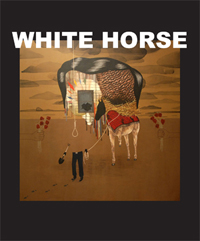 White Horse
White Horse
Multi-authored chapbook (Including work by writers: Harold Abramowitz, Saehee Cho, John Cleary, Traci O Connor, Jennifer Denrow, Andrew Farkas, Sandy Florian, Paul Gacioch, Evelyn Hampton, Paul Hardacre, HL Hazuka, Kristen Jorgenson, Carrie-Sinclair Katz, Bob Marcacci, rob mclennan, Shane Michalik, Megan Milks, Cathi Murphy, Eireene Nealand, Kristen Orser, Kristin Prevallet, Zach Savich, Michael Sikkema, Jason Snyder, & James Wagner)
Sidebrow, March 2012
78 pages / $12 Buy from Sidebrow
Being a combinatory effort from a number of authors, it should strike one as no surprise that White Horse seems to be a dialogic narrative. The title remaining somewhat obtuse, save for a specific reference near the end (and tho how can we assume a meaning over all), haunts the work as a whole. In consideration of a multi-authored novel there are two routes one can take—the first being to consider the book as a book, authorless, the second being to consider the book a work of collaboration.
While I had a hope that the book would read authorless, it’s unfortunate that this is not the case. The authors are given attribution at the end of the book, and there are striking divides within the stylistic approaches each few pages take. One can feel the authors who repeat. This posits the book ultimately within the realm of collaboration, and ultimately more of a multi-person dialog than anything else. A novel experiment, it ends up seeming more of an exercise in curation rather than a coherent whole.
That’s not to say that the book isn’t good, but the “goodness” or “badness” of a book is never what is at issue in a review, at least not my own. There are exciting moments, and tracing the dialog between stories is literally fun, because it throws the element of play back into literature at a very active level. But ultimately the tangents are just borrowed words or elements, and thus the book becomes an exquisite corpse of vague narration and short works that all could stand on their own.
While the issue of autonomy is not one that, perhaps, is important, to consider the idea of the book as a book, the experiment has failed. Ultimately the book reads more as an anthology or lit journal instead of a collaborative book. So, if we move beyond the book as book and consider the book as collaboration, or perhaps more specifically curation, what’s to be said?
We could read this as a formally experimental lit journal (which, I suppose, Sidebrow itself actually is), and on that level it’s certainly interesting, but ultimately I don’t think the text succeeds in doing anything remarkably new. There are gems of prose and words and poetry within, but upon reading the first word that came to mind was “typical.” I don’t want to necessarily berate this fact; if you enjoy whatever micro-narrative poetry & prose is being called currently (is it still called flash fiction?), I could suggest with certainty that this would be a pleasurable read for you.
But I fear much of the content, outside of the form, fails to transcend the trappings of what has come to be understood at “indie lit.” A more thematically “adult” literature than the parallel of the “independent film considered as a sub-genre,” sure, but there’s nothing really surprising in here if you’ve read any number of good lit journals.
The absence of separation/demarcation of author serves more to homogenize the work, throughout forms and modes, than it does to fulfill a fully coherent whole (i.e. the book). It’s unfortunate that this fails to cohere into an open totality, but is interesting nonetheless.
Tags: Sidebrow, White Horse
